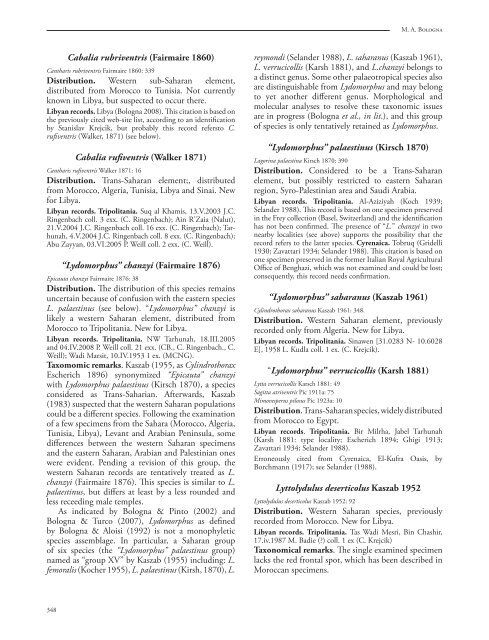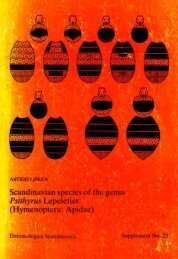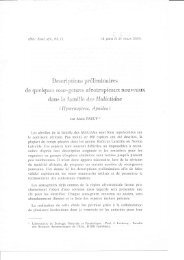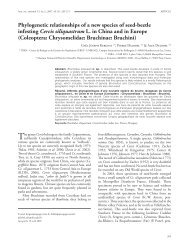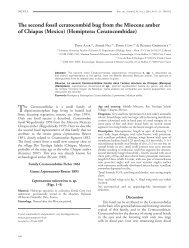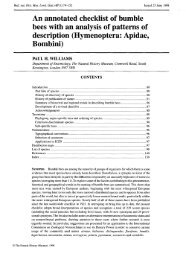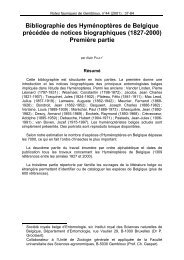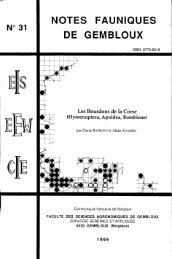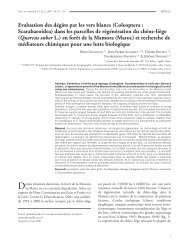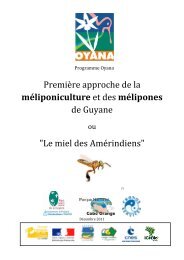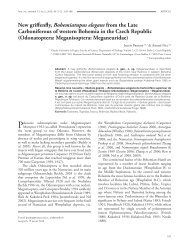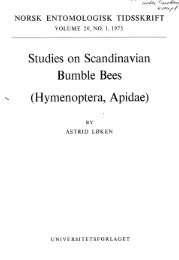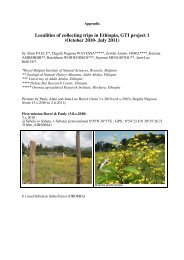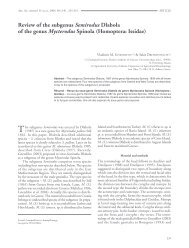Bologna 2009 - Beetles and Rock Art in Libya - Free
Bologna 2009 - Beetles and Rock Art in Libya - Free
Bologna 2009 - Beetles and Rock Art in Libya - Free
You also want an ePaper? Increase the reach of your titles
YUMPU automatically turns print PDFs into web optimized ePapers that Google loves.
M. A. <strong>Bologna</strong><br />
Cabalia rubriventris (Fairmaire 1860)<br />
Cantharis rubriventris Fairmaire 1860: 339<br />
Distribution. Western sub-Saharan element,<br />
distributed from Morocco to Tunisia. Not currently<br />
known <strong>in</strong> <strong>Libya</strong>, but suspected to occur there.<br />
<strong>Libya</strong>n records. <strong>Libya</strong> (<strong>Bologna</strong> 2008). This citation is based on<br />
the previously cited web-site list, accord<strong>in</strong>g to an identification<br />
by Stanislav Krejcik, but probably this record refersto C.<br />
rufiventris (Walker, 1871) (see below).<br />
Cabalia rufiventris (Walker 1871)<br />
Cantharis rufiventris Walker 1871: 16<br />
Distribution. Trans-Saharan element;, distributed<br />
from Morocco, Algeria, Tunisia, <strong>Libya</strong> <strong>and</strong> S<strong>in</strong>ai. New<br />
for <strong>Libya</strong>.<br />
<strong>Libya</strong>n records. Tripolitania. Suq al Khamis, 13.V.2003 J.C.<br />
R<strong>in</strong>genbach coll. 3 exx. (C. R<strong>in</strong>genbach); A<strong>in</strong> R’Zaia (Nalut),<br />
21.V.2004 J.C. R<strong>in</strong>genbach coll. 16 exx. (C. R<strong>in</strong>genbach); Tarhunah,<br />
4.V.2004 J.C. R<strong>in</strong>genbach coll. 8 exx. (C. R<strong>in</strong>genbach);<br />
Abu Zayyan, 03.VI.2005 P. Weill coll. 2 exx. (C. Weill).<br />
“Lydomorphus” chanzyi (Fairmaire 1876)<br />
Epicauta chanzyi Fairmaire 1876: 38<br />
Distribution. The distribution of this species rema<strong>in</strong>s<br />
uncerta<strong>in</strong> because of confusion with the eastern species<br />
L. palaest<strong>in</strong>us (see below). “Lydomorphus” chanzyi is<br />
likely a western Saharan element, distributed from<br />
Morocco to Tripolitania. New for <strong>Libya</strong>.<br />
<strong>Libya</strong>n records. Tripolitania. NW Tarhunah, 18.III.2005<br />
<strong>and</strong> 04.IV.2008 P. Weill coll. 21 exx. (CB., C. R<strong>in</strong>genbach., C.<br />
Weill); Wadi Marsit, 10.IV.1953 1 ex. (MCNG).<br />
Taxomomic remarks. Kaszab (1955, as Cyl<strong>in</strong>drothorax<br />
Escherich 1896) synonymized “Epicauta” chanzyi<br />
with Lydomorphus palaest<strong>in</strong>us (Kirsch 1870), a species<br />
considered as Trans-Saharian. Afterwards, Kaszab<br />
(1983) suspected that the western Saharan populations<br />
could be a different species. Follow<strong>in</strong>g the exam<strong>in</strong>ation<br />
of a few specimens from the Sahara (Morocco, Algeria,<br />
Tunisia, <strong>Libya</strong>), Levant <strong>and</strong> Arabian Pen<strong>in</strong>sula, some<br />
differences between the western Saharan specimens<br />
<strong>and</strong> the eastern Saharan, Arabian <strong>and</strong> Palest<strong>in</strong>ian ones<br />
were evident. Pend<strong>in</strong>g a revision of this group, the<br />
western Saharan records are tentatively treated as L.<br />
chanzyi (Fairmaire 1876). This species is similar to L.<br />
palaest<strong>in</strong>us, but differs at least by a less rounded <strong>and</strong><br />
less receed<strong>in</strong>g male temples.<br />
As <strong>in</strong>dicated by <strong>Bologna</strong> & P<strong>in</strong>to (2002) <strong>and</strong><br />
<strong>Bologna</strong> & Turco (2007), Lydomorphus as def<strong>in</strong>ed<br />
by <strong>Bologna</strong> & Aloisi (1992) is not a monophyletic<br />
species assemblage. In particular, a Saharan group<br />
of six species (the “Lydomorphus” palaest<strong>in</strong>us group)<br />
named as “group XV” by Kaszab (1955) <strong>in</strong>clud<strong>in</strong>g: L.<br />
femoralis (Kocher 1955), L. palaest<strong>in</strong>us (Kirsh, 1870), L.<br />
reymondi (Sel<strong>and</strong>er 1988), L. saharanus (Kaszab 1961),<br />
L. verrucicollis (Karsh 1881), <strong>and</strong> L.chanzyi belongs to<br />
a dist<strong>in</strong>ct genus. Some other palaeotropical species also<br />
are dist<strong>in</strong>guishable from Lydomorphus <strong>and</strong> may belong<br />
to yet another different genus. Morphological <strong>and</strong><br />
molecular analyses to resolve these taxonomic issues<br />
are <strong>in</strong> progress (<strong>Bologna</strong> et al., <strong>in</strong> lit.), <strong>and</strong> this group<br />
of species is only tentatively reta<strong>in</strong>ed as Lydomorphus.<br />
“Lydomorphus” palaest<strong>in</strong>us (Kirsch 1870)<br />
Lagor<strong>in</strong>a palaest<strong>in</strong>a Kirsch 1870: 390<br />
Distribution. Considered to be a Trans-Saharan<br />
element, but possibly restricted to eastern Saharan<br />
region, Syro-Palest<strong>in</strong>ian area <strong>and</strong> Saudi Arabia.<br />
<strong>Libya</strong>n records. Tripolitania. Al-Aziziyah (Koch 1939;<br />
Sel<strong>and</strong>er 1988). This record is based on one specimen preserved<br />
<strong>in</strong> the Frey collection (Basel, Switzerl<strong>and</strong>) <strong>and</strong> the identification<br />
has not been confirmed. The presence of “L.” chanzyi <strong>in</strong> two<br />
nearby localities (see above) supports the possibility that the<br />
record refers to the latter species. Cyrenaica. Tobruq (Gridelli<br />
1930; Zavattari 1934; Sel<strong>and</strong>er 1988). This citation is based on<br />
one specimen preserved <strong>in</strong> the former Italian Royal Agricultural<br />
Office of Benghazi, which was not exam<strong>in</strong>ed <strong>and</strong> could be lost;<br />
consequently, this record needs confirmation.<br />
“Lydomorphus” saharanus (Kaszab 1961)<br />
Cyl<strong>in</strong>drothorax saharanus Kaszab 1961: 348.<br />
Distribution. Western Saharan element, previously<br />
recorded only from Algeria. New for <strong>Libya</strong>.<br />
<strong>Libya</strong>n records. Tripolitania. S<strong>in</strong>awen [31.0283 N- 10.6028<br />
E], 1958 L. Kudla coll. 1 ex. (C. Krejcik).<br />
“Lydomorphus” verrucicollis (Karsh 1881)<br />
Lytta verrucicollis Karsch 1881: 49<br />
Sagitta atriventris Pic 1911a: 75<br />
Mimovesperus pilosus Pic 1923a: 10<br />
Distribution. Trans-Saharan species, widely distributed<br />
from Morocco to Egypt.<br />
<strong>Libya</strong>n records. Tripolitania. Bir Milrha, Jabel Tarhunah<br />
(Karsh 1881: type locality; Escherich 1894; Ghigi 1913;<br />
Zavattari 1934; Sel<strong>and</strong>er 1988).<br />
Erroneously cited from Cyrenaica, El-Kufra Oasis, by<br />
Borchmann (1917); see Sel<strong>and</strong>er (1988).<br />
Lyttolydulus deserticolus Kaszab 1952<br />
Lyttolydulus deserticolus Kaszab 1952: 92<br />
Distribution. Western Saharan species, previously<br />
recorded from Morocco. New for <strong>Libya</strong>.<br />
<strong>Libya</strong>n records. Tripolitania. Tas Wadi Mesri, B<strong>in</strong> Chashir,<br />
17.iv.1987 M. Badie (?) coll. 1 ex (C. Krejcik)<br />
Taxonomical remarks. The s<strong>in</strong>gle exam<strong>in</strong>ed specimen<br />
lacks the red frontal spot, which has been described <strong>in</strong><br />
Moroccan specimens.<br />
348


